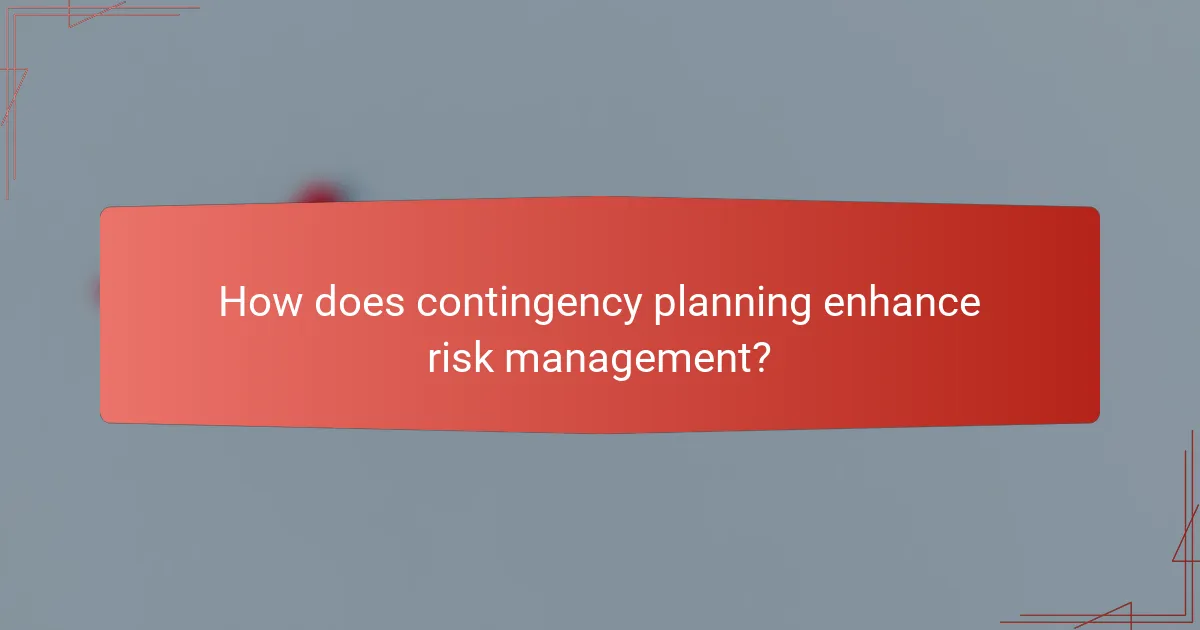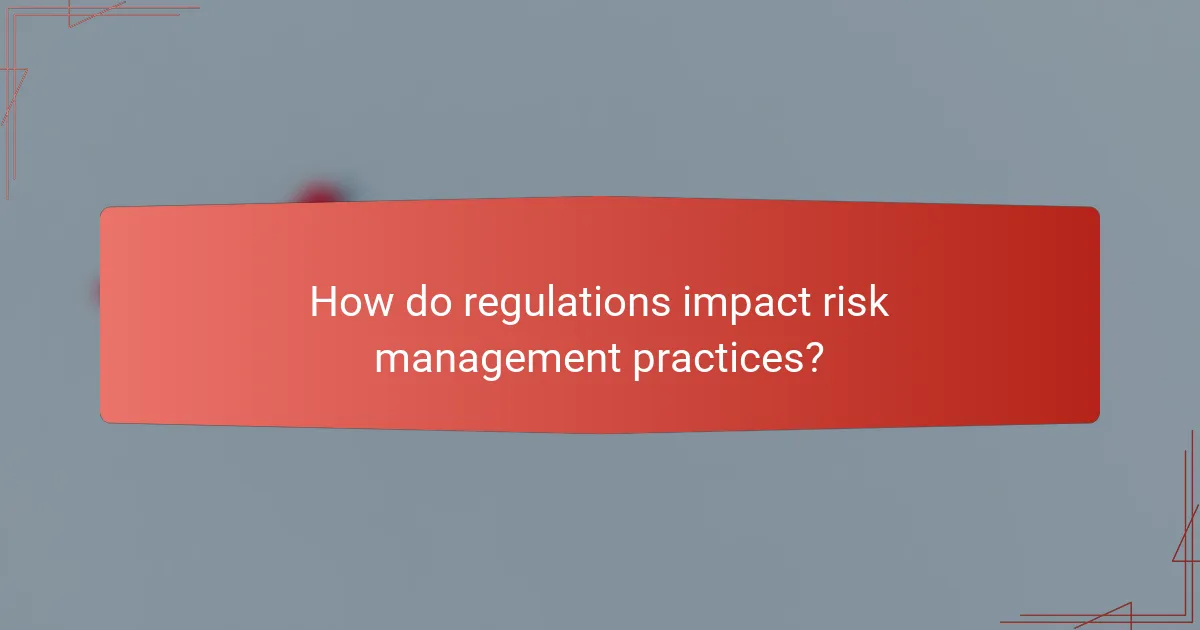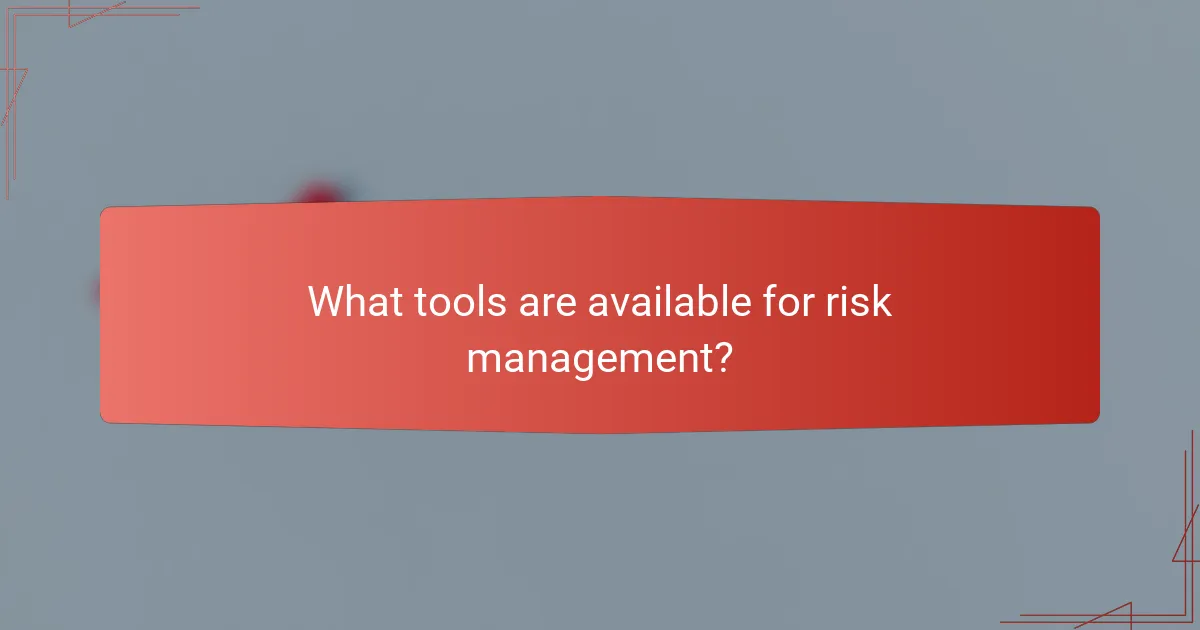Effective risk management practices are essential for businesses to safeguard their assets and ensure operational continuity. By utilizing strategies such as insurance, diversification, and contingency planning, organizations can mitigate financial risks and prepare for unforeseen challenges. These approaches not only protect against potential losses but also enhance overall resilience in an unpredictable environment.

How can insurance mitigate risks in business?
Insurance can significantly reduce financial risks for businesses by providing coverage against various unforeseen events. By transferring the risk to an insurance provider, companies can protect their assets, operations, and revenue streams from potential losses.
Types of insurance policies
Businesses can choose from several types of insurance policies to address specific risks. Common policies include property insurance, which covers damage to physical assets, and workers’ compensation insurance, which protects against employee injuries. Additionally, professional liability insurance safeguards against claims of negligence or malpractice.
Other essential policies include commercial auto insurance for vehicle-related risks and cyber liability insurance to protect against data breaches. Each type of policy serves a unique purpose and can be tailored to the specific needs of a business.
Benefits of business interruption insurance
Business interruption insurance offers financial protection when a company cannot operate due to a covered event, such as a natural disaster or fire. This type of insurance helps cover lost income and ongoing expenses, allowing businesses to maintain operations during recovery periods.
For example, if a restaurant suffers damage from a flood, business interruption insurance can compensate for lost revenue while repairs are made. This coverage is crucial for maintaining cash flow and ensuring that businesses can recover without incurring crippling financial losses.
Role of liability insurance in risk management
Liability insurance plays a vital role in risk management by protecting businesses from legal claims and lawsuits. This type of insurance covers legal fees, settlements, and judgments arising from claims of negligence, injury, or property damage caused by the business’s operations.
For instance, if a customer is injured on a company’s premises, general liability insurance can cover the associated costs. By having adequate liability coverage, businesses can mitigate the financial impact of legal disputes and focus on their core operations without the constant threat of litigation.

What is diversification in risk management?
Diversification in risk management refers to the practice of spreading investments or resources across various assets or sectors to reduce exposure to any single risk. This strategy aims to minimize potential losses by ensuring that not all investments are affected by the same adverse event.
Investment diversification strategies
Investment diversification strategies involve allocating funds among different asset classes, such as stocks, bonds, real estate, and commodities. By diversifying, investors can mitigate risks associated with market volatility, as different assets often react differently to economic changes.
Common strategies include investing in index funds, which provide broad market exposure, or using a mix of domestic and international assets to capture growth in various economies. It’s crucial to regularly review and adjust your portfolio to maintain an optimal balance based on market conditions.
Benefits of diversifying revenue streams
Diversifying revenue streams can significantly enhance a business’s stability and resilience. By generating income from multiple sources—such as product sales, services, and investments—companies can reduce their reliance on any single revenue source, which protects against market fluctuations.
For example, a company that sells both physical products and digital services can better withstand economic downturns affecting one sector. Additionally, diversifying revenue can lead to new growth opportunities and improve overall financial health, making it easier to secure funding or attract investors.

How does contingency planning enhance risk management?
Contingency planning significantly enhances risk management by preparing organizations for unexpected events that could disrupt operations. It involves developing strategies to respond effectively to potential risks, ensuring business continuity and minimizing losses.
Key components of effective contingency plans
Effective contingency plans typically include risk assessment, response strategies, communication plans, and recovery procedures. Risk assessment identifies potential threats, while response strategies outline specific actions to take during a crisis. Communication plans ensure that all stakeholders are informed, and recovery procedures detail how to restore operations post-incident.
Additionally, regular testing and updating of these plans are crucial. This ensures that the strategies remain relevant and effective in addressing new risks as they arise. Organizations should conduct drills and simulations to evaluate the readiness of their contingency plans.
Examples of contingency planning in major corporations
Major corporations like Coca-Cola and IBM have demonstrated effective contingency planning. Coca-Cola developed a comprehensive crisis management plan to address potential supply chain disruptions, allowing them to maintain product availability during unforeseen events. Their proactive approach includes alternative sourcing and logistics strategies.
IBM, on the other hand, employs a robust business continuity plan that includes data backup and recovery systems. This ensures that critical data is protected and can be restored quickly, minimizing downtime and maintaining customer trust. These examples highlight the importance of tailored contingency plans in safeguarding against various risks.

What are the best practices for implementing risk management strategies?
The best practices for implementing risk management strategies include thorough planning, regular assessments, and effective communication. These practices help organizations identify potential risks, develop mitigation plans, and ensure preparedness for unforeseen events.
Steps to develop a risk management framework
To develop a risk management framework, start by identifying the types of risks your organization may face, such as financial, operational, or reputational risks. Next, assess the likelihood and impact of each risk, prioritizing them based on their potential effect on your operations.
Once risks are prioritized, create a risk mitigation plan that outlines specific strategies to address each risk. This may include purchasing insurance, diversifying investments, or implementing contingency plans. Finally, establish a monitoring system to regularly review and update the framework as necessary.
Importance of regular risk assessments
Regular risk assessments are crucial for maintaining an effective risk management strategy. They allow organizations to identify new risks that may arise due to changes in the market, technology, or regulatory environment. Frequent assessments ensure that existing risks are still relevant and that mitigation strategies remain effective.
Conducting risk assessments at least annually is recommended, but more frequent evaluations may be necessary in dynamic industries. Utilize a combination of qualitative and quantitative methods to gain a comprehensive understanding of your risk landscape, and involve key stakeholders in the assessment process to ensure diverse perspectives are considered.

How do regulations impact risk management practices?
Regulations significantly influence risk management practices by establishing compliance requirements that organizations must follow. These rules can dictate how companies assess, mitigate, and report risks, thereby shaping their overall risk management strategies.
Overview of compliance requirements
Compliance requirements vary by industry and jurisdiction, often encompassing data protection, financial reporting, and operational standards. Organizations must stay informed about relevant regulations, such as the Sarbanes-Oxley Act for financial transparency or industry-specific guidelines.
Failure to comply can lead to severe penalties, including fines and reputational damage. Therefore, businesses should regularly review their compliance status and adjust their risk management practices accordingly.
Impact of GDPR on risk management
The General Data Protection Regulation (GDPR) imposes strict rules on how organizations handle personal data, significantly affecting risk management practices. Companies must implement robust data protection measures and conduct regular risk assessments to identify vulnerabilities related to personal data processing.
To comply with GDPR, organizations should establish clear data handling policies, train employees on data protection, and ensure that data breaches are reported within a specified timeframe. Regular audits and updates to risk management strategies are essential to maintain compliance and protect against potential fines, which can reach up to 4% of annual global turnover.

What tools are available for risk management?
Risk management tools encompass various strategies and technologies designed to identify, assess, and mitigate potential risks. Key tools include insurance, software solutions, and contingency planning frameworks that help organizations manage uncertainties effectively.
Software solutions for risk assessment
Software solutions for risk assessment provide organizations with the ability to analyze and quantify risks systematically. These tools often include features for data collection, risk modeling, and reporting, which facilitate informed decision-making.
Examples of popular risk assessment software include RiskWatch, Resolver, and LogicManager. These platforms can help organizations streamline their risk management processes, ensuring compliance with industry standards and regulations.
Benefits of using risk management platforms
Utilizing risk management platforms offers several advantages, such as improved accuracy in risk identification and enhanced collaboration among team members. These tools can centralize risk data, making it easier to track and manage risks across different departments.
Additionally, risk management platforms often provide real-time analytics and reporting capabilities, allowing organizations to respond quickly to emerging risks. By leveraging these tools, businesses can not only reduce potential losses but also enhance their overall resilience.

What emerging trends are shaping risk management?
Emerging trends in risk management are increasingly driven by technology, evolving regulatory landscapes, and the need for resilience in uncertain environments. Organizations are adopting innovative practices to enhance their risk assessment and mitigation strategies, ensuring they can respond effectively to new challenges.
Impact of technology on risk management practices
Technology is transforming risk management by enabling more accurate data analysis and real-time monitoring. Tools such as artificial intelligence and machine learning help organizations identify potential risks earlier and automate responses, reducing human error and improving efficiency.
For example, predictive analytics can forecast market fluctuations, allowing companies to adjust their strategies proactively. Additionally, cloud-based risk management solutions facilitate collaboration and data sharing across departments, enhancing overall risk visibility.
Future of risk management in a post-pandemic world
The COVID-19 pandemic has reshaped risk management, emphasizing the importance of contingency planning and adaptability. Organizations are now prioritizing flexible strategies that can quickly pivot in response to unforeseen events, such as health crises or supply chain disruptions.
Moving forward, businesses should focus on building resilience through diversified supply chains and robust insurance policies. Regularly updating risk assessments and engaging in scenario planning can help organizations prepare for various potential future challenges, ensuring they remain agile and responsive.



